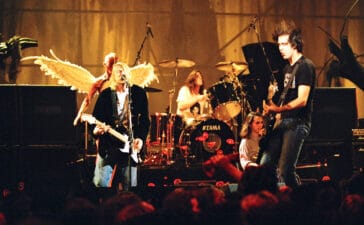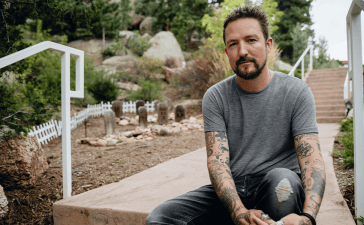Opening Up…sees us talk to musicians about the opening track from each of their studio albums. Our next guest is Jerry Cantrell, best known as the lead guitarist and founding member of grunge legends Alice in Chains. Away from the iconic multi-platinum selling band, the Tacoma native has also sporadically forged a solo career – which he’s now returned to in 2021 with his first solo album in 19 years, ‘Brighten’, out now.
“Been talking to a lot of cool folks today!” Jerry Cantrell is in high spirits as he gets on the line with BLUNT, excited about some degree of human interaction after so long stowed away. Sure, it’s not playing music in the flesh – that’s still to come – but having a tangible opportunity to discuss music (his music, no less) is a welcome change for the 55-year-old.
As always, the preamble leads to a query as to what the guest of Opening Up likes in an opening track for an album – not just as a songwriter, but as a fan. In Cantrell’s case, it’s about forging something with consistency – if you’ve gone all out for the closer, you better have gone all out for the opener. “ I think it’s got to be something that’s really immediate – like, ‘there it is, man, you’re in‘ – with its energy,” he says.
“Generally speaking, the first tracks on any record that I’ve been been involved with, I’ve wanted to put one of the best – if not the best song – right up front. It’s always an interesting process with track-listing – I’ve found that probably about 98% of the time the people you’re working with are on the same wavelength. The Alice guys and I all live pretty independently of one another, but when we exchange notes for a new record it’s really funny because we’re mostly pretty close despite not having spoken to one another about it previously. One thing that we’re about 100% on every time is where we’re starting and where we’re ending.” Well, what are we waiting for? Let’s get started – we begin on Cantrell’s solo career, before revisiting the classic era of Alice In Chains as a bonus round.
Dickeye” – Boggy Depot (1998)
We know what you’re thinking. Hell, it’s exactly what we were thinking. Nevertheless, however, but: Dickeye isn’t anything like that. “A dickeye is a one when you roll a dice,” Cantrell explains. “Myself and a few of the guys who worked on that record are big gamblers, and there was a lot of dice being played in the studio at the time. Dickeye is also slang for the barrel of a gun, so that factored in as well.”
Cantrell explains that the opener to his debut solo album Boggy Depot was written from the second-person perspective of a hitman – or, if not a hitman, at the very least a person who had taken another’s life in their own hands. “It’s about the idea of what it takes to do that,” he says. “It’s not something you might initially pick up on, just because there’s a lot of focus on the riff, and how melodic the song is. I remember I was playing the song back in the studio with Les Claypool, who was sitting in for a few tracks on bass. He told me he thought the chorus was a bit Paul McCartney – I could definitely hear a little ‘Jet’ once he’d said that.”
Joining Claypool on Boggy Depot was a bevvy of other top-tier musicians: Pantera and Down bassist Rex Brown, Fishbone frontman Angelo Moore on saxopohone and even Cantrell’s Alice in Chains bandmates Sean Kinney and Mike Inez. “Dickeye” was forged with Kinney on drums and Brown on bass, who hold down the groove while Cantrell does what he does best: Sling riffs and sing close harmony. “It’s a great riff!” he says, reminiscing on his bygone handiwork. “Sean was a real security blanket and safety net throughout that album, too – it was my first time making a record out on my own away from the band, and he really helped me keep it together.”
“Psychotic Break” – Degradation Trip Volume 1 (2002)
Cantrell ended up with a well of new material following the release of Boggy Depot – so much so that he ended up with well over two hours’ worth of recorded songs. This was initially meant to be released all at once, but due to his label’s hesitancy at the time Degradation Trip was broken up over two volumes, released within months of one another. Volume 1 arrived at a tumultuous time for Cantrell: Alice in Chains ended months prior with the passing of frontman Leyne Staley, and as a means to differentiate as a solo artist he has none of his bandmates appearing on the album.
“This whole record was a dark journey,” Cantrell recalls. “I wrote it all a year or two before I got sober. I think that’s why we had to go with ‘Psychotic Break’ to start it – that song is just so doomy! You get that real sense of dread as soon as it starts, right from the first note and as the chanting comes in. I’ll always remember playing the whole record to Dime[bag Darrell, Pantera guitarist] – ‘Psychotic Break’ was his favourite tune by far.”
Cantrell was backed here by Faith No More’s Mike Bordin on drums and bassist Rob Trujillo – at the time playing with Ozzy Osbourne and Black Label Society, but within a year he’d pass the audition to join Metallica. The rhythm section add some extra snarl to the drop-C waltz that ensues, which feels a lot more metal-inspired than anything on Boggy Depot – and, indeed, anything Alice in Chains had done.
“I really wanted to encapsulate the story of an artist, the journey that they go on,” says Cantrell. “Looking back, I’d say that song encapsulates that more than any other. All of the songs on Degradation Trip are connected, but I don’t think I would have ever picked any other track to open that album.”
“Castaway” – Degradation Trip Volume 2 (2002)
Some five months after Volume 1 came Degradation Trip‘s second edition, released as part of the complete expansion on both double CD and quadruple vinyl – which was a rare feat for the early 2000s, long before the LP records once again replaced compact discs as physical versions of choice. With the full album in place, some rearrangements were made: “Psychotic Break” remained as the opening track of the entire thing, but track nine of Volume 1 – the chugging, dizzying head-nodder “Castaway” – was recontextualised as Volume 2‘s opener. This, according to Cantrell, was the plan all along – and now that Degradation Trip was out in its entirety, it was finally being heard in the right setting.
“Every song on that record was written while I was living up in the mountains, about an hour out of Seattle,” he says. “I was writing on a white Les Paul, and just as I was starting to write it fell over one day and the headstock cracked. Somehow, though, the neck didn’t break and it still kept in tune – I didn’t change the strings for four months out of fear something else might happen to it.”
To enhance the song’s heavy tones – in turn, making the song even heavier – Cantrell played a baritone guitar on “Castaway.” For those unfamiliar, a baritone guitar enlists an even longer neck than your standard electric guitar. This allows for a much lower sound than usual – giving a whole heap of low-end in the process, somewhere in-between a bass and a guitar. “It’s a trick I learned from Dave Jerden,” says Cantrell, alluding to the producer behind the boards for Alice in Chains’ first two albums. “It really adds a lot of colour to your song when you play one – and for a song that’s about someone swimming to a desert isle from a shipwreck, you definitely need that colour.”
“Atone” – Brighten (2021)
A quick recap of the 19 years separating Degradation Trip and Brighten: Cantrell got sober, reformed Alice in Chains, released three new AiC records and toured the globe a half-dozen times. Days before lockdown engulfed the planet, however, Cantrell entered the studio in North Hollywood to begin making Brighten. A year in the making, the world was introduced to the album with the release of “Atone” in late July – making it both the lead single and the opening number.
“I moved it around a few times, but it ended up belonging in that opening spot,” says Cantrell. “We were talking earlier about exchanging notes, and that’s what I did with all the guys who worked on this record – Greg Puciato, Paul Fig, Tyler Bates. We all agreed it was a strong contender on both fronts, being an opener and a single. It has a certain attitude – they’re completely different songs with completely different subject matter, but it has the same sort of mood as a song like ‘Psychotic Break’.”
Cantrell goes on to describe the creation of “Atone” as one of constant trial and error. Having come up with the riff years prior but not using it on any Alice in Chains material, he circled back to it when work began on Brighten in early 2020. “I wanted to complete it for years, but I just never seemed to have the right parts for it,” Cantrell says. “When I chanced upon that chorus melody over the riff, after playing it over and over, it really started to feel like we’d begun to crack the code on it. We ended up with a really amazing song, I feel.”
“Atone” is also noted by Cantrell as being “a very visual song,” which is testified to with its music video. Shot in black and white, the clip sees Cantrell wandering the Joshua Tree desert on his lonesome, with only his guitar to guide him. “I think that video represents a lot of imagery that song evokes in my head,” he says. “I think it’s a really good way to listen to it, having the video playing at the same time. It probably makes a lot more sense when you do.”
“We Die Young” – Facelift (Alice in Chains, 1990)
It’s a curious thing to compare and contrast Cantrell’s most recent work with his earliest. Prior to appearing as the opener on Facelift, Alice in Chains’ debut, “We Die Young” also served as the title track to a three-song EP released earlier that year. For many at the time, this song was their introduction to the young up-and-coming rock band – and yes, they were a rock band back then; this was before the word “grunge” was even in the lexicon. It remains a staple of Alice in Chains’ live show too, having been played by the band over 700 times in concert. The only songs that have been played live more by them are their two biggest hits, “Man in the Box” and “Would?”. They must have done something right, don’t you think?
“We knew we were onto something there,” says Cantrell of the song. “It was one of the earliest riffs I had written for the band, and we just went for it. It’s just so guttural, and so raw. It’s a very powerful song. It’s only two-and-a-half minutes, too. Right to the point – like a classic album opener should be. For the first thing anybody was gonna hear from this band, I’m glad it was this song.”
The song’s snarling riff is also emblematic of one of Cantrell’s favourite aspects of guitar playing: drop-tuning, in which the lowest three strings form their own chord simply by being played openly. If you hear chugging riffs that often comes back to one low note, there’s a good chance it’s in drop-tuning. “I picked it up from watching Van Halen,” Cantrell explains. “Ironically enough, it was when I was trying to learn the song ‘Unchained’. It really caught my ear – I was like, ‘What is that? It doesn’t sound like it was tuned right.’ When I discovered that it was in drop-D, it completely opened up my world.”
“Them Bones” – Dirt (Alice in Chains, 1992)
On now to Cantrell’s most famous opener from his band’s most famous album. Although it doesn’t often get talked about with the same hushed reverence as Nirvana’s Nevermind or Pearl Jam’s Ten, 1992’s Dirt absolutely deserves to be – not only is it a genre-defining release, it’s a legacy-defining release.
It all begins with the crushing opener “Them Bones,” which has also gone on to serve as a staple of Alice in Chains’ live show and remains one of their most popular and memorable songs to date. “That’s one of my prouder riffs,” says Cantrell – a sentiment you can’t help but agree with. “I mean, I’m pretty proud of everything that we’ve done, but that riff is pretty sick. When Leyne [Staley, former vocalist] comes in with the vocals, the guitar hits this ‘weeeeew’ sound, and it’s just so powerful.”
Much like “We Die Young,” “Them Bones” also gets much of its power from Cantrell’s drop-tuning riff. While the former was in drop-D, however, “Bones” goes even harder by tuning down even further to drop-C sharp – which is pretty damn heavy, as it goes. “I was very enthralled with that tuning,” Cantrell laughs. “What can I say? There’s just something about that heaviness, tuning those bottom strings into its own chord, and really giving the riffs you write with it an extra bit of bounce. I’ve used it many times over the years, and will absolutely continue to do so.”
As with the other singles from Dirt, “Them Bones” was considerably successful. It cracked the top 40 of the UK singles charts, as well as the rock charts back at home. In Cantrell’s mind, however, the song’s greatest success was its acknowledgement from someone he would come to count as a peer. “I was reading an interview with James Hetfield, a guy that I really respect,” he says. “He said that ‘Them Bones’ was one of the songs that was part of his pre-gig routine – he’d listen to the song in order to amp himself up before playing a show. That’s when I knew we’d done it.”
“Grind” – Alice in Chains (Alice in Chains, 1995)
A lot changed following the release of Dirt. The classic lineup shifted with the departure of bassist Mike Starr, while Cantrell himself began taking more turns on lead vocals alongside Staley. A key instance of this was “Grind,” which not only opened the band’s eponymous third album but also served as its lead single. It’s one of three songs Cantrell takes lead on, and notes a shift from him being the band’s right-hand man to ostensibly its leader.
“That was the first song that I wrote for the record,” Cantrell recalls. “I can remember meeting up with Sean at the office of our manager, Susan Silver. There was already some real excitement when I played the tape – Sean knew that we were off to a good start. I was really drawn to industrial music at the time – that real sense of mechanical playing – so I kind of wanted to do that, but through the lens of Alice in Chains.”
Cantrell also notes “Grind” as one of his personal favourites to play live. It still gets a run in setlists, although now trying to divide attention across six studio albums makes it a little difficult to evenly distribute. “It’s a good qualitative problem to have, I think,” reasons Cantrell. “At the end of the day, it’s really about what the fans want out of you.
“I’ll use Metallica as an example – years ago, they did an all-request tour to try and shake things up from their usual sets. As it turned out, most of the requests that they got were for songs they were already playing on tour! We won’t ever do a show without playing ‘Man in the Box’, or ‘Would?’, or ‘Rooster’… the list goes on. Talking about all these songs has reminded me how much I love playing, and I really hope I can come back and play them for you in Australia soon.”









